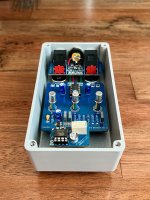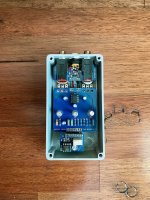PedalBuilder
Well-known member
- Build Rating
- 5.00 star(s)
What to say? It's a Tone Bender Mk. II with a few slight modifications. Sonically, it's unmistakeably a Tone Bender Mk. II. I tuned it to have a little more gating and less cleanup. It does the Zeppelin thing in spades—whenever I turn it on, I invariably find myself wanting to start playing Dazed and Confused.
I used some NOS Siemens AC153Y transistors for this build. The transistor measurements are:
Q1: hFE 82, leakage 226 µA
Q2: hFE 84, leakage 354 µA
Q3: hFE 109, leakage 330 µA
Measured on a Peak DCA55 at 73ºF
The collector voltages are:
Q1: -7.76v
Q2: -0.11v
Q3: -8.34v
VCC: -9.12v
(For less gating and more cleanup, try to get the Q2 collector voltage above 0.2v, and the Q3 collector voltage between 7.3 and 7.5v. I was able to do that on the breadboard by using a transistor with the same gain and leakage around 220µA. It's definitely a circuit that benefits from some experimentation before building.)
The Tone Bender Mk. II was only in production for from 1966 to 1968. Despite its brief production run, there were quite a few variations on the component values, which Andrew Hopkins of Vero-P2P has helpfully catalogued. I used his table as a starting point when tuning my build. I ended up mostly following the Vox Professional MKII Tone Bender values, with a few small changes:



I used some NOS Siemens AC153Y transistors for this build. The transistor measurements are:
Q1: hFE 82, leakage 226 µA
Q2: hFE 84, leakage 354 µA
Q3: hFE 109, leakage 330 µA
Measured on a Peak DCA55 at 73ºF
The collector voltages are:
Q1: -7.76v
Q2: -0.11v
Q3: -8.34v
VCC: -9.12v
(For less gating and more cleanup, try to get the Q2 collector voltage above 0.2v, and the Q3 collector voltage between 7.3 and 7.5v. I was able to do that on the breadboard by using a transistor with the same gain and leakage around 220µA. It's definitely a circuit that benefits from some experimentation before building.)
The Tone Bender Mk. II was only in production for from 1966 to 1968. Despite its brief production run, there were quite a few variations on the component values, which Andrew Hopkins of Vero-P2P has helpfully catalogued. I used his table as a starting point when tuning my build. I ended up mostly following the Vox Professional MKII Tone Bender values, with a few small changes:
- I increased the Q1 base-ground resistor from 10kΩ to 24kΩ. This resistor and Q1's leakage work together to set the bias for Q1. In the original Tone Benders, this was typically 10kΩ or 100kΩ, depending on how leaky the transistors were. I tried a range of values, and settled on 24kΩ because it sounded best with this particular set of transistors.
- To increase the volume without meaningfully changing the tone, I replaced the 470Ω and 8.2kΩ resistors that form a voltage divider on the Q3 collector with 1.2kΩ and 7.5kΩ resistors. The total collector resistance is more or less unchanged, but the output volume is noticeably higher, making it much easier to get unity gain or a slight volume boost. (And as a bonus, the output impedance is lowered from 212Ω to 83Ω.)
- I used a C1k for the Attack control rather than the B1k. Unlike the Fuzz Face, the Attack control on the Tone Bender sounds great at all settings. But with these particular transistors, much of the action happened in the last quarter of the Attack control's location when using a linear taper, so I swapped it for a C-taper to make the behavior of the Attack control more even.
- I added a 100nF ceramic decoupling capacitor to the power supply (more out of habit than anything else).



Last edited:

